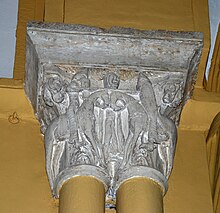
Back የእግዚአብሔር ሰላምና ስምምነት Amharic سلام و هدنة الله Arabic Божи мир Bulgarian Pax et treuga Dei Breton Pau i Treva de Déu Catalan Ειρήνη και εκεχειρία του Θεού Greek Dia Armistico Esperanto Paz y tregua de Dios Spanish Jumalarahu Estonian صلح و آتشبس الهی Persian
This article has an unclear citation style. (June 2022) |

The Peace and Truce of God (Latin: Pax et treuga Dei) was a movement in the Middle Ages led by the Catholic Church and was one of the most influential mass peace movements in history.[2] The goal of both the Pax Dei and the Treuga Dei was to limit the violence of feuding in the western half of the former Carolingian Empire – following its collapse in the middle of the 9th century – using the threat of spiritual sanctions.[3] The eastern half of the former Carolingian Empire did not experience the same collapse of central authority, and neither did England.[4] This movement was also marked by popular participation, with many commoners supporting the movement as a solution to the famines, violence, and collapse of the social order around them.[5]
The Peace of God was first proclaimed in 989, at the Council of Charroux. It sought to protect ecclesiastical property, agricultural resources and unarmed clerics.[6] The Truce of God, first proclaimed in 1027 at the Council of Toulouges, attempted to limit the days of the week and times of year that the nobility engaged in violence.[7] The movement survived in some form until the thirteenth century.
Other strategies to deal with the problem of violence in the western half of the former Carolingian Empire included the code of chivalry.
- ^ Guinea, Miguel Angel García; Montañés, José Manuel Rodríguez; Hernando, J. Antonio Ruiz; Robledo, José Luis Gutiérrez; Campóo), Centro de Estudios del Románico (Monasterio de Santa María la Real de Aguilar de (March 8, 2002). Enciclopedia del románico en Castilla y León. Fundación Santa María la Real, Centro de Estudios del Románico. ISBN 9788489483767 – via Google Books.
- ^ Backman, Clifford R. The worlds of medieval Europe. Oxford, UK: Oxford University Press, 2003, 210.
- ^ Head and Landes, The Peace of God, 1.
- ^ Daileader 2001. Those Who Fought.
- ^ Paxton, Frederick S. (1987). "The Peace of God in Modern Historiography: Perspectives and Trends". Historical Reflections / Réflexions Historiques. 14 (3): 385–404. ISSN 0315-7997. JSTOR 23232407.
- ^ Head 1999. p. 656.
- ^ Cowdrey, H.E.J. The Peace and the Truce of God in the Eleventh Century. p. 44.
© MMXXIII Rich X Search. We shall prevail. All rights reserved. Rich X Search